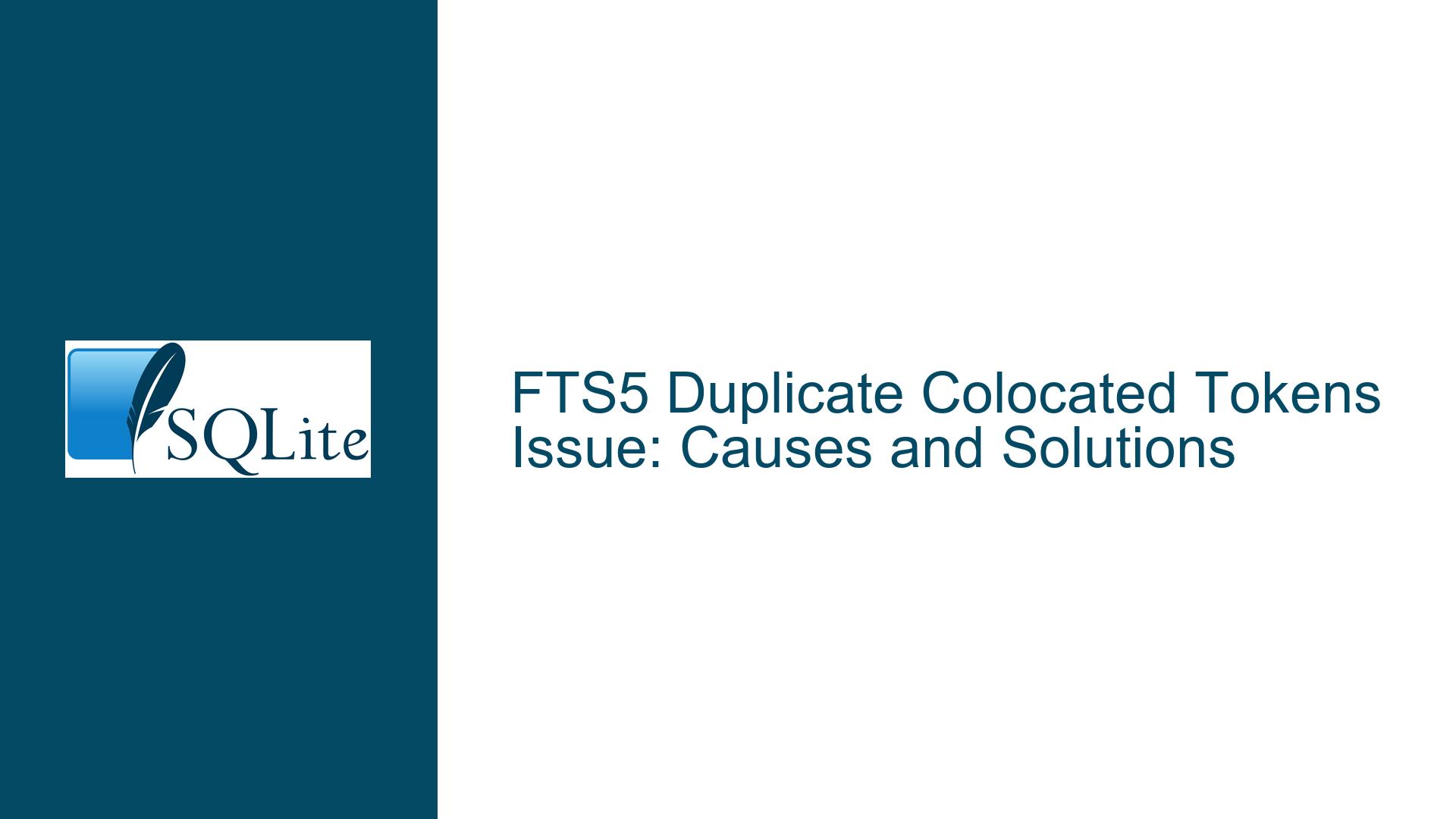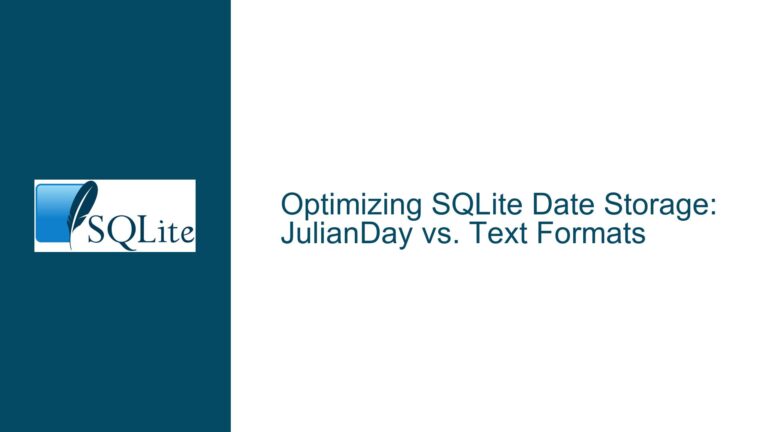FTS5 Duplicate Colocated Tokens Issue: Causes and Solutions
Issue Overview: FTS5 Fails to Detect Duplicate Colocated Tokens
The core issue revolves around the behavior of SQLite’s FTS5 (Full-Text Search version 5) module when handling duplicate colocated tokens. Colocated tokens are tokens that are treated as synonyms or variants of the same term, such as "first" and "1st." In FTS5, these tokens are typically marked using the FTS5_TOKEN_COLOCATED flag during tokenization. The problem arises when the same colocated token is passed multiple times to the xToken callback function, which is responsible for processing tokens during indexing.
When a tokenizer repeatedly passes the same colocated token to xToken, FTS5 does not detect or filter out these duplicates. Instead, it appends each instance as a separate entry in the underlying FTS5 index structures. This behavior can lead to an inflated index size and potentially impact search performance. For example, if the token "first" is passed 5,000 times with the FTS5_TOKEN_COLOCATED flag, FTS5 will create 5,000 separate entries for "first" in the index, even though they represent the same logical token.
This issue is particularly problematic during development and testing, where tokenization logic might be imperfect or subject to frequent changes. Developers may inadvertently introduce duplicate tokens due to overlapping tokenizer logic, such as when multiple tokenizer wrappers are used in combination (e.g., one for Unicode normalization, another for lowercasing, and another for handling synonyms). The lack of duplicate detection in FTS5 means that these duplicates persist in the index, leading to unexpected behavior and potential performance degradation.
Possible Causes: Why FTS5 Does Not Filter Duplicate Colocated Tokens
The root cause of this issue lies in the design and implementation of FTS5’s token handling mechanism. FTS5 treats each call to xToken as a distinct event, regardless of whether the token being passed is a duplicate of a previously processed token. This design choice reflects FTS5’s focus on flexibility and performance, as it avoids the overhead of maintaining state to track previously seen tokens during tokenization.
One reason for this behavior is that FTS5 does not assume that tokens passed to xToken are unique. In some cases, duplicate tokens might be intentional, such as when a document contains multiple instances of the same word or when a user wants to boost the ranking score of a particular term by repeating it. However, this assumption does not account for the specific case of colocated tokens, where duplicates are more likely to be accidental and undesirable.
Another factor contributing to this issue is the modular nature of tokenizer design. Developers often create multiple tokenizer wrappers to handle different aspects of tokenization, such as Unicode normalization, lowercasing, and synonym handling. When these wrappers are combined, they can inadvertently introduce duplicate tokens. For example, a Unicode tokenizer might pass "first" to xToken, followed by a synonym tokenizer that passes "1st" and then "first" again as colocated tokens. Without explicit deduplication logic, FTS5 will process all three tokens as separate entries.
The lack of built-in duplicate detection in FTS5 also reflects a trade-off between simplicity and functionality. Adding duplicate detection would require FTS5 to maintain additional state during tokenization, which could increase memory usage and processing time. For most use cases, this overhead might not be justified, especially since duplicates can often be avoided through careful tokenizer design.
Troubleshooting Steps, Solutions & Fixes: Addressing Duplicate Colocated Tokens in FTS5
To address the issue of duplicate colocated tokens in FTS5, developers can take several approaches, ranging from modifying tokenizer logic to implementing custom deduplication mechanisms. Each approach has its trade-offs in terms of complexity, performance, and maintainability.
1. Modify Tokenizer Logic to Prevent Duplicates
The most straightforward solution is to ensure that tokenizers do not generate duplicate colocated tokens in the first place. This can be achieved by adding deduplication logic within the tokenizer itself. For example, a tokenizer could maintain a set of previously processed tokens and skip any duplicates before calling xToken. This approach is particularly effective when multiple tokenizer wrappers are used, as it prevents duplicates from being introduced at the source.
However, this solution requires careful implementation to avoid introducing performance bottlenecks. Maintaining a set of previously seen tokens can increase memory usage, especially for large documents or high-frequency tokens. Additionally, developers must ensure that deduplication logic does not interfere with legitimate cases where duplicate tokens are intentional.
2. Implement a Deduplication Wrapper
Another approach is to create a dedicated tokenizer wrapper that handles deduplication. This wrapper would sit between the main tokenizer and FTS5, intercepting calls to xToken and filtering out duplicates before they reach FTS5. This approach has the advantage of being modular and reusable, as the same deduplication wrapper can be used with multiple tokenizers.
The deduplication wrapper would need to track the position and context of each token to ensure that only true duplicates are filtered out. For example, it would need to distinguish between multiple instances of the same token within a document (which should be preserved) and multiple colocated tokens representing the same logical term (which should be deduplicated). This requires careful handling of token positions and colocation flags.
3. Use FTS5’s Tombstone Mechanism for Document Deletion
While not a direct solution to the duplicate token issue, FTS5’s tombstone mechanism can help mitigate the impact of duplicates during document deletion. When a document is deleted, FTS5 marks its tokens as tombstones in the index. These tombstones are used to ensure that the document’s tokens are no longer included in search results. Importantly, a single tombstone is used for all instances of the same token within a document, regardless of whether they are colocated or not.
This means that even if a document contains duplicate colocated tokens, deleting the document will remove all instances of those tokens from the index in a single operation. While this does not prevent duplicates from being added in the first place, it ensures that they do not persist in the index after the document is deleted.
4. Optimize Tokenizer Design to Minimize Duplicates
Developers can also reduce the likelihood of duplicate tokens by optimizing the design of their tokenizers. This includes consolidating tokenizer logic to avoid overlapping functionality and ensuring that each tokenizer wrapper performs a distinct and non-redundant role. For example, instead of having separate wrappers for Unicode normalization, lowercasing, and synonym handling, these functions could be combined into a single wrapper that processes tokens in a single pass.
This approach requires a deep understanding of the tokenization pipeline and careful planning to avoid introducing new issues. However, it can significantly reduce the complexity of the tokenizer and improve overall performance by minimizing redundant processing.
5. Monitor and Clean Up Duplicates in the Index
For cases where duplicates have already been introduced into the FTS5 index, developers can implement a cleanup process to identify and remove them. This involves querying the FTS5 index to detect duplicate entries and then updating or rebuilding the index to remove them. While this approach is more resource-intensive than preventing duplicates in the first place, it can be useful for addressing existing issues in production environments.
The cleanup process would typically involve querying the fts5vocab table, which provides a vocabulary of all tokens in the index along with their frequencies. By analyzing this table, developers can identify tokens with unusually high frequencies and investigate whether they are the result of duplicate colocated tokens. Once identified, these duplicates can be removed by rebuilding the affected portions of the index.
6. Advocate for Future Enhancements to FTS5
Finally, developers can advocate for future enhancements to FTS5 that address the duplicate colocated token issue. This could include adding an option to enable duplicate detection during tokenization or providing a built-in mechanism for deduplicating colocated tokens. While this approach does not provide an immediate solution, it can help improve FTS5 for the broader community and reduce the need for workarounds in the long term.
In conclusion, the issue of duplicate colocated tokens in FTS5 is a nuanced problem that requires careful consideration of tokenizer design and FTS5’s internal mechanisms. By understanding the root causes and implementing appropriate solutions, developers can mitigate the impact of duplicates and ensure optimal performance of their full-text search applications.






